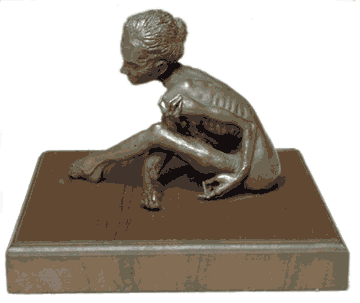The Diet that Nobody Needs
Cachexia (pronounced ka-kek-sia)
is involuntary weight loss that occurs in cancer patients even with
apparently adequate nutritional intake. Its symptoms
may include anorexia, debility, and malnutrition, or they may consist
solely of weight loss. The quantity of weight lost has
no correlation with size, location, or type of tumor.
A diminutive tumor can substantially affect the weight of the host;
tumor release of mainly undetected soluble factors is thought to
be responsible for this startling potency.
Almost one-half of hospitalized adult cancer patients have lost
at least 10 percent of their body weight. One-quarter
of these patients have lost 20 percent or more. Virtually
all patients with disseminated (scattered and abundant) metastasis show evidence of cachexia.
Cachexia varies in severity; there is metabolic dysfunction
even when cachexia does not strip the weight. The direct cause
of lost weight is often difficult to determine,
and can be complicated by factors such as tumor location
and therapeutic measures taken. Loss of appetite may also
be an indirect effect of depression. But cancer itself
may secrete contributing factors. Tumors implanted in
animals and causing anorexia sometime resolve when the tumor is removed.
Survival of some with certain forms of cancer can be more accurately
predicted from the severity of the cancer cachexia than from the
type of therapy received, as cachexia and anorexia mean that prognosis is poor.
Carbohydrate Metabolism Changes with Cancer
Ordinarily, you eat carbohydrates to produce energy. But when a body has cancer, carbohydrates may actually drain that body of energy to feed the tumor.
A person showing signs of cachexia may feel better, and avoid nourishing the tumor, if he
or she avoids foods and liquids containing simple carbohydrates, such as sugar,
honey, and milk products.
Cachexia is often accompanied by anorexia, malabsorption,
energy expenditure, and humoral factors. In less than a majority but
nevertheless a significant number of patients, taste is affected, and is
reported to pertain most often to sweet flavors, followed by salt and sour.(8)
Some develop an aversion to meat. Certain food aversions are attributable to
an association being formed between that food and the nauseating therapy, and can to some extent be
combated with the introduction of novel foods when nausea is absent.
Protein Metabolism in Cancer
In cancer cachexia, both patient and tumor have the same protein
requirements, but cancer cells generally have a higher growth rate, and
therefore demand--and obtain--more protein. This may cause the breakdown of
protein for patient and tumor to exceed the amount that comes into the body.
When that happens, the cancer causes the body to begin breaking down its own
muscle tissue to meet its protein requirements. Insufficient protein supply can
affect immune response, gastrointestinal function, and healing.
High-quality protein contains the amino acids from which the body
reconstructs its own protein.
So that cancer patients get enough protein to meet increased bodily needs,
they may benefit from increasing the amount of protein they eat.
Appetite and food intake is heavily influenced by the hypothalamus, a tiny but critical
structure at the base of the brain; in turn, the hypothalamus is affected by
substances borne in the blood.(3,5) These humoral or blood-borne factors, including hormones,
peptides, and amino acids, are often afflicted in advanced stages of cancer.
Peptide and hormone levels affected by tumor cells are likely to influence
feeding.
Glucagon, for example, suppresses appetite and has been modestly
elevated in cachectic patients.
Levels of the transmitter serotonin in the brain
relate inversely to appetite—more serotonin means less hunger.
Tryptophan, the
precursor to serotonin, is elevated in brains of anorectic cancer patients and
not in food-deprived and tumor-free animals, further aligning serotonin with
appetite loss; yet serotonin antagonists do not dispel the anorexia.
Insulin
increases feeding and weight gain in cancer-free animals and has thus been
enlisted to combat anorexia. But cachectic patients do not respond normally to
insulin; their tissues lose sensitivity to it. When insulin does increase
feeding in tumor-bearing animals, it does not seem to prolong survival. Even
forced feeding seems incapable of prolonging survival.
Lipid Metabolism in Cancer
Most of the weight loss in humans and animals with cancer
comes from loss of fat. Even this has a drawback. The dissolved fat puts undesirable substances such
as cholesterol into the bloodstream.
The food that is ingested by cancer patients may not be adequately
absorbed.
Intestinal malabsorption is sometimes, but not
always, attributable to such direct influences as fistula, surgery,
or therapy. The reason for malabsorption in patients
with no obvious reason for it is relatively unexplored.
Longstanding cancer can increase metabolic rate, thus contributing
to energy expenditure and weight loss in the patient, but this finding
is not consistent.
Because the quantity of tumor tissue in hypermetabolic
patients is insufficient to account entirely for the amount of weight
these patients lose, other hypotheses, such as cancer-induced futile
biochemical cycles, have been proposed. Anaerobic glucose
metabolism and increased protein synthesis, discussed more completely
elsewhere, account for part of the energy lost. There
is evidence that tumor cells secrete factors, and cause its host
to secrete factors, that induce such effects as angiogenesis and
proteolysis. Other factors released may simply diminish
the desire for food.
The best treatment for cancer cachexia
is removal of the malignancy. When that cannot be accomplished, at
least the devastation of cachexia can be contested.

